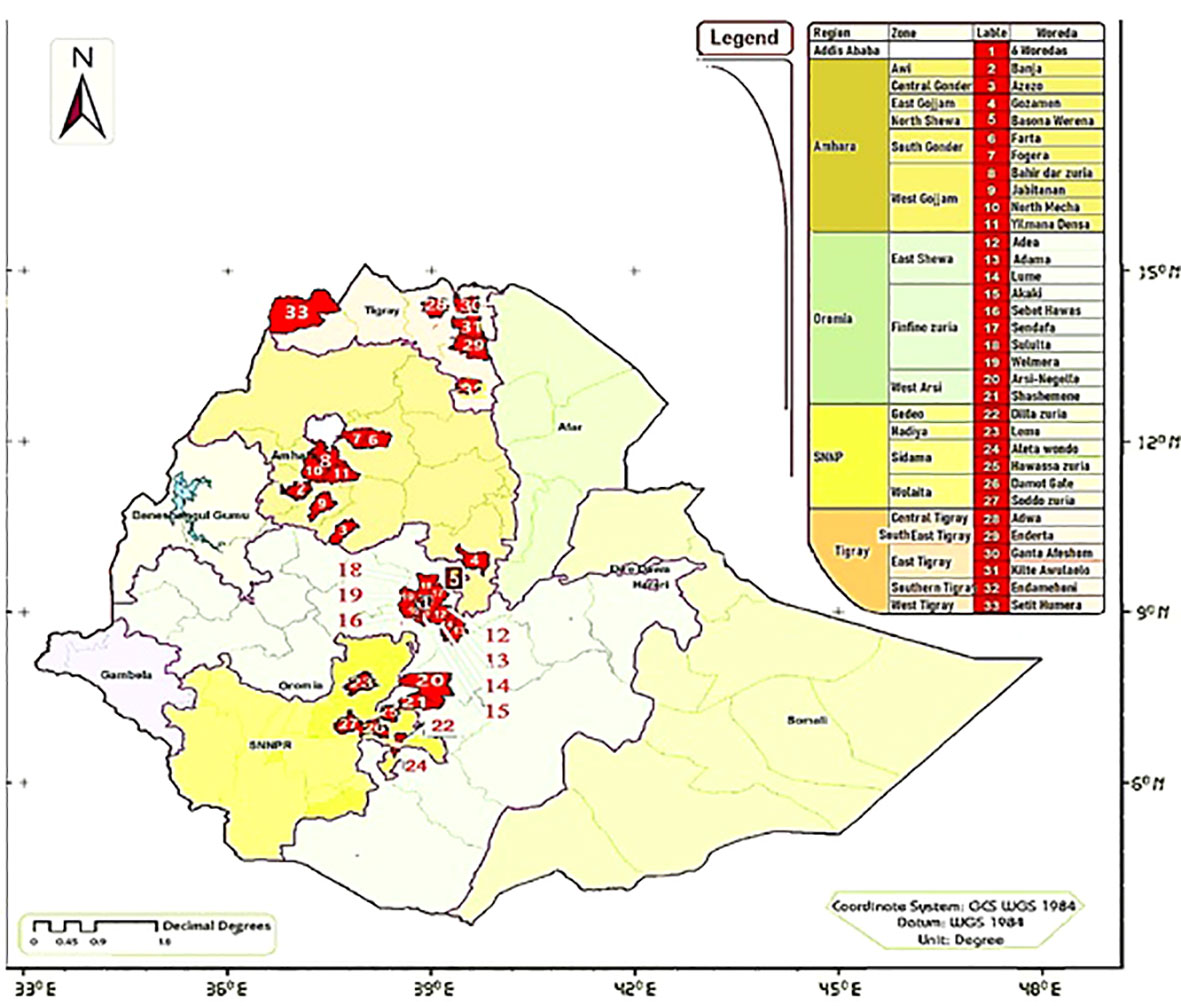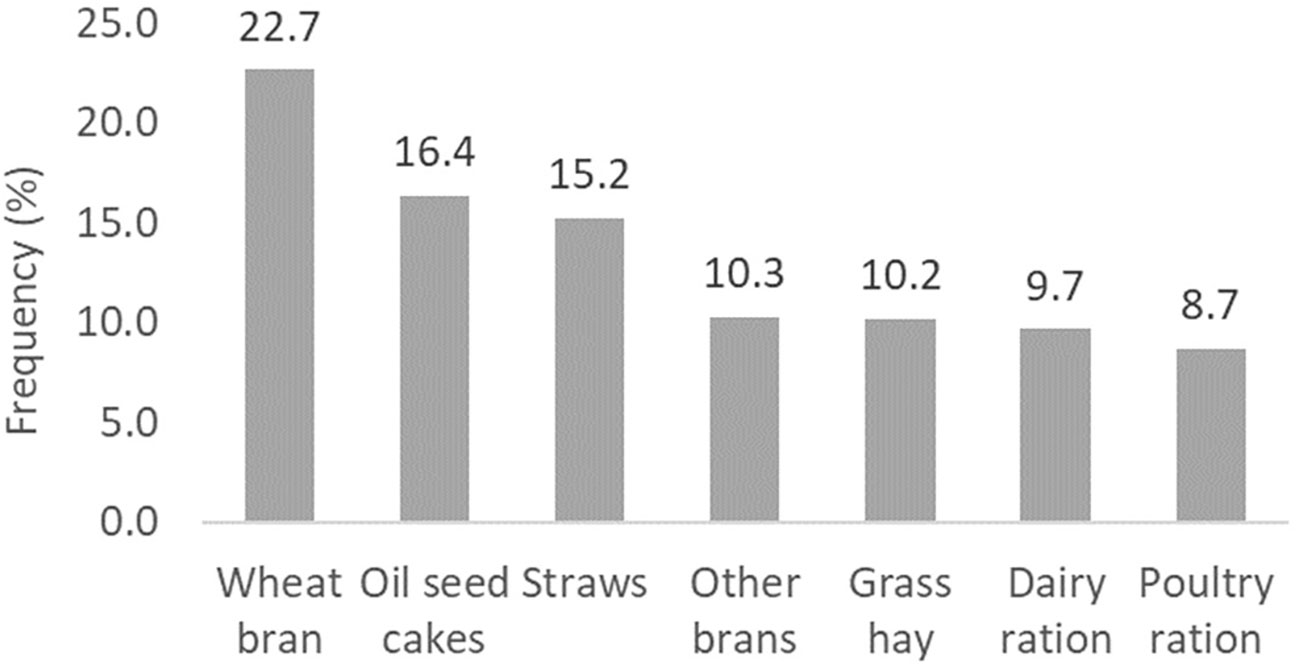Price-quality relationships for the main livestock feed types in the Ethiopian feed market
- 1Ethiopian Institute of Agricultural Research (EIAR), Addis Ababa, Ethiopia
- 2Department of Microbial, Cellular and Molecular Biology, Addis Ababa University (AAU), Addis Ababa, Ethiopia
- 3Feed and Forage Development Programme, International Livestock Research Institute (ILRI), Addis Ababa, Ethiopia
- 4Global Academy of Agriculture and Food Systems, University of Edinburgh, Edinburgh, United Kingdom
This study assessed the price-quality relationships for the major feed products in Ethiopia with a view to informing policy makers on possible avenues to develop the livestock feed sector in the country. A survey of livestock feed markets was conducted from April to May 2019 in five regions (Amhara, Southern Nations Nationalities and Peoples Region (SNNPR), Oromia, Tigray and Addis Ababa). A total of 1700 feed samples with their respective price information were collected from 202 marketplaces. The collected samples were analyzed for their crude protein (CP), neutral detergent fibre (NDF), acid detergent fibre (ADF), in vitro organic matter digestibility (IVOMD) and metabolisable energy (ME) content. Results showed considerable variability in quality within the same feed type. Pearson correlation and regression analyses showed that price-quality relationships for the feed samples were either very weak or non-existent. Wheat bran showed a weak price to quality correlation for CP (r= 0.200 at P<0.01), ME (r= 0.202 at P<0.01) and IVOMD (r= 0.221 at P<0.01). Among the roughages, grass hay showed slight positive price to ME correlation (r= 0.382 at P<0.001) and a slight negative relationship with ADF (r=-0.336 at p<0.005). The results of this study indicated that quality attributes have no, or a limited role in setting market prices for most feed types in the Ethiopian feed market. The fact that both good and poor-quality feeds are sold under the same label and market value affects both traders and livestock producers. Therefore, it is important to build national feed analytical capabilities to allow quality of feeds to be checked against national feed standards, particularly for concentrate feeds.
Introduction
Livestock production is an integral component of farming systems in Ethiopia (Mengistu et al., 2017). The sector has considerable social and economic importance at both household and national levels. It contributes close to half of the agricultural GDP and provides employment opportunities to about 73% of the rural population directly or indirectly (Central Statistical Agency, 2018). At the household level, livestock provide a range of services including being a source of income, animal protein food, manure hides and skins, farm power (transport and ploughing) and other social services (Asresie, 2015). Despite the large livestock population in Ethiopia, animal productivity remains low (Mengistu et al., 2021). As a result there is a considerable yield gap between the potential production and what is currently achieved (Mayberry et al., 2017). Measures to close yield gap between the actual and the potential production level are an important development strategy to meet the growing demand for livestock products, create further employment opportunities and support the national economy (Shapiro et al., 2017). One of the main reasons for the low livestock productivity is feed shortages and the poor quality of available feeds (FAO, 2018; FAO, 2019). In the highland crop-livestock systems, the majority of smallholder livestock keepers depend on poor quality crop residues to feed their ruminant livestock (Duncan et al., 2016). In urban and peri- urban areas, where livestock are reared for market, purchased feeds are an important component of the diet of dairy and meat animals. Peri-urban dairy farming using crossbred cows has been particularly increasing due to the growing demand for dairy products in urban centres (Menale, Melaku, 2019). The feed market has also been expanding and various feed resources, including cereal and oilseed agro-processing by-products, compound feeds, crop residues, hay, and green fodder, are traded in the local market (Dejene et al., 2014; Yosef et al., 2022). However, several feed market assessment reports indicate a considerable increase in the price of feed over the years (Gebremedhin et al., 2009; Bediye et al., 2018; Yami et al., 2020; Negash, 2022). The presence of a well-regulated feed market is important to support profitable livestock enterprises in the country. In Ethiopia, information is scarce as to how feed prices are related to the quality of feed products in the local market and whether quality dictates the price of the products. However, studies in other Sub-Saharan African countries like Mali (Ayantunde et al., 2014), and Niger (Jarial et al., 2016) indicate that price is not determined by the nutrition quality of feed stuffs. The objective of this study was therefore to assess variations in quality within and among feed products and determine
price-quality relationships for the major feed products across the country with a view to informing policy makers on possible avenues to improve the livestock feed sector in Ethiopia.
Materials and methods
Study areas
The study was conducted in five regions of Ethiopia (Amhara, Southern Nations Nationalities and Peoples Region (SNNPR), Oromia, Tigray and Addis Ababa) in April-May 2019. These are the regions of Ethiopia which are either urban or where mixed crop-livestock farms dominate and where feed transactions are common.
In each region, representative urban and peri-urban feed marketplaces, feed processing sites, and livestock enterprises were identified along main road networks connecting towns and cities as shown in Figure 1. District level experts from the District Offices of Agriculture were used as key
informants to identify active feed market actors for the study. Accordingly, a total of 32 rural woredas (districts) in the four regions along with six woredas in Addis Ababa were included in the sample (Figure 1). A range of market outlets were included in the study. These were mainly comprised of non-commercialized feed processors or ration formulators, commercial feed processors and agribusiness retailers.
Data collection
From each selected woreda, six feed sellers were randomly selected based on their proximity to main roads. We bought one kilogram of sample from each feed type in the feed markets. A total of one thousand seven hundred samples were collected with each clearly labelled with their respective price. The feed types included roughages (grass hay, barley straw, tef straw, wheat straw), concentrate feed ingredients (barley bran, brewery by-products, cotton seed cake, linseed cake, maize grain, noug seed cake, pulse bran, rice bran, sorghum bran, soybean cake, wheat bran, wheat grain) and formulated feeds (poultry ration and dairy ration). During sampling at a market point, care was taken to take a representative sample of each feed ingredient. A small portion of each feed type was picked from different sides, homogenised and representative samples of approximately 1kg each were collected in paper bags and labelled with the necessary tracing information including feed type, date of collection, unit price, and the location of the feed seller.
Sample preparation and chemical composition analysis
Sample preparation and analysis were carried out at the International Livestock Research Institute (ILRI) animal nutrition laboratory. The samples were oven dried at 60°C for 48 hours and ground through a 1 mm sieve using a Christy mill. Samples were then scanned by Near Infrared Reflectance Spectroscopy using a FOSS 5000, with the Win ISI software package and specific calibration equations, and spectra were stored. Five hundred and fifty feed samples were analysed using standard laboratory methods (“wet chemistry”) for the purpose of developing calibrations using NIRS for prediction of the nutritive values of a further 1200 feed samples.
For the wet chemistry analysis, dry matter and nitrogen contents were determined according to (AOAC, 1995) procedure. Nitrogen content of the samples was determined using the Kjeldahl method and steam distillation was done using a Kjeltec Model 1026 distillation unit (Foss Technology Corp.) AOAC method 976.05 was used to determine crude protein (CP) (the percentage of nitrogen obtained from the feed samples multiplied by 6.25). Neutral detergent fibre (NDF) and acid detergent fibre (ADF) were determined according to Van Soest and Robertson (1985). In vitro organic matter digestibility (IVOMD) and metabolisable energy were analysed according to Menke and Steingass (1988) and calculated according to Blümmel and Ørskov (1993).
Near Infrared Spectroscopy (NIRS) analysis
The NIRS instrument used was a FOSS 5000 Feed Analyser with software package WinISI 4.6.2. A total of 1700 samples were scanned with NIRS to determine their dry matter (DM), crude protein (CP) estimated from nitrogen content (N x 6.25), neutral detergent fibre (NDF), acid detergent fibre (ADF), in vitro organic matter digestibility (IVOMD) and metabolisable energy (ME) concentrations.
Data analysis
Descriptive statistics were used to present the mean chemical composition of the feed samples collected. The data were summarised as mean ± standard error (SE). The prices of the feed samples were then related with the laboratory analysis results. Pearson correlation analysis and linear regression were conducted to explore the relationships between price and feed quality variables using SAS software (Version 9.0).
Results
Feed types traded in selected marketplaces in Ethiopia
The feed market analysis result showed that the main feed types traded in the selected markets in Ethiopia were agro-industrial by-products followed by crop residues and grass hay. In terms of frequency of products on sale, wheat bran contributed about 22.7%, oil seed cakes 16.4%, crop residue 15.2% and grass hay 10.2% (Figure 2). Beside their relative abundances, wheat bran and oil seed cakes also contribute as main components of compound feeds formulated and marketed by feed processing companies.
Nutritive value of the livestock feeds
The results of feed chemical composition analyses are summarised in Tables 1–3. The results indicate considerable variability in quality within the same feed type (Table 1). For instance, crude protein (CP) concentration for wheat bran, ranged from 6.6% to 23.6% with an average value of 15.8% ± 0.13. The in vitro organic matter digestibility (IVOMD) of wheat bran ranged from 44.3% to 74.7% with a mean value of 70.8% ± 0.24. The mean metabolisable energy (ME) value was 10.2 MJ/kg DM ± 0.04 with a range of 6.5 to 10.8 MJ/kg DM. Among the cereal by-products shown in Table 4, brewery by-products contained the highest mean CP concentration (23.9 ± 0.93), while wheat bran showed the highest mean value of IVOMD (70.8 ± 0.24) on a DM basis. Oil seed cakes also showed considerable variation in their nutritive value within the same feed type. For instance, the mean CP concentration of noug seed cake was 34.2%, with a range of 15% - 46%. Similarly, the IVOMD of noug seed cake varied widely, ranging from 43% to 68%, with a mean of 58%. Among the oil seed cakes, soybean cake contained the highest CP% (45.7 ± 0.93) and IVOMD% (82.9 ± 1.04).

Table 1 Chemical composition of selected roughages (mean ± SE) collected in selected market places in Ethiopia.

Table 2 Chemical composition of selected formulated concentrate feeds (% mean ± SE) collected from marketplaces in Ethiopia.
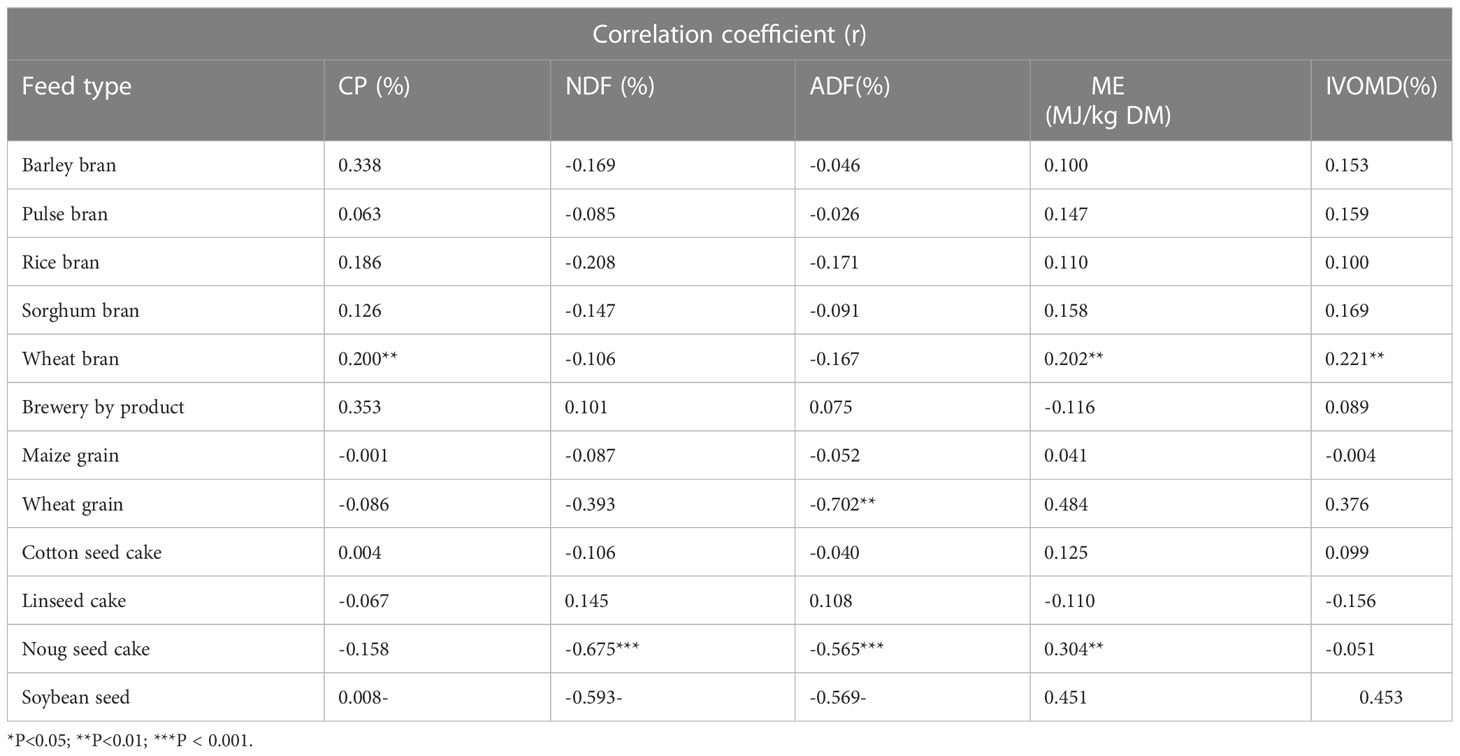
Table 3 Pearson correlation coefficient (r) between quality and price (Birr/kg) for selected concentrate feed ingredients collected from selected marketplaces in Ethiopia.
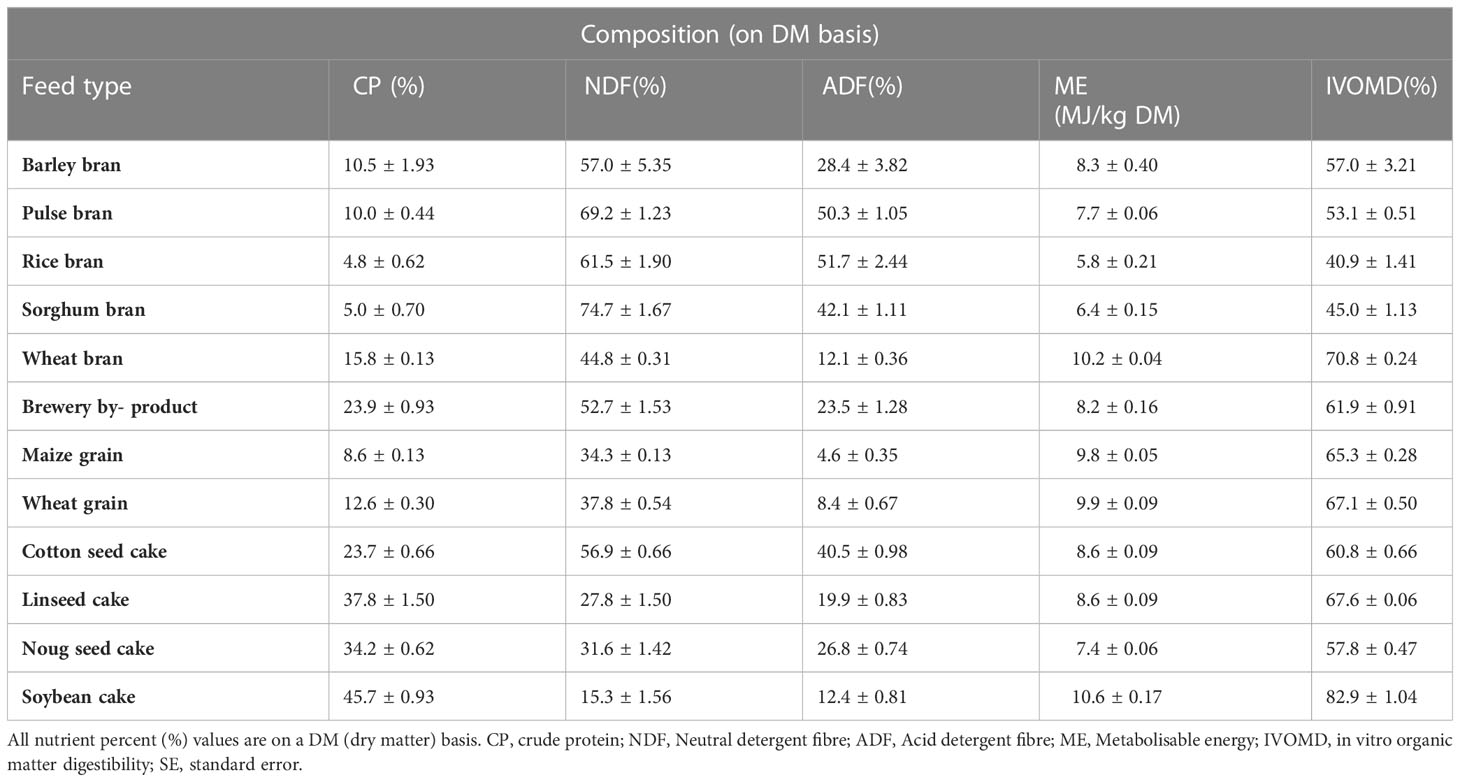
Table 4 Nutritive value of selected concentrate feeds (mean ± SE) collected in selected market places in Ethiopia.
The average chemical composition of the selected roughages collected from marketplaces are shown in Table 1. The mean CP% of wheat straw was 3.1% ± 0.10 with a range of 1.5% - 5.7%. The mean IVOMD of wheat straw was 39.3% ± 0.23, ranging from 35% to 45% on a DM basis. Grass hay showed higher mean CP% compared to wheat straw (5.9% ± 0.52), but there was large variation in CP content with some samples having as low as 1% CP and others as high as 13%. Similarly, green grass samples showed a large variation in CP content (4% to 25%).
Table 2 presents the composition of formulated rations found in the local market. As was the case for feed ingredients, formulated rations showed a large variation in nutrient concentration. For instance, crude protein (CP) concentration of the dairy ration ranged from 6% to 28% with a mean of 18.6 ± 0.46. The in vitro organic matter digestibility (IVOMD) of the same product ranged from 45% to 69% with a mean of 62.8 ± 0.55. The mean metabolisable energy value was 8.8 MJ/kg± 0.08 with a range of 6 to 10 MJ/kg DM.
Relationship between feed quality and price
In this study, the majority of feed suppliers were also engaged in feed processing or ration formulation. Maize grain, wheat bran and noug cake were the most common feed ingredients used for production of formulated feed. Individual producers or cooperatives, processors and wholesalers were the major sources of the feed ingredients. The main source of maize grain was individual producers or cooperatives while wheat bran was mainly supplied by wholesalers in addition to individual producers or cooperatives. Exploration of the relationships between the price of different feed ingredients and their nutritive value showed that for the majority of agro-industrial by-products, there was no significant relationship between price and quality of the feed ingredients sold in the feed markets (Table 3; Figures 3–6). Exceptions were noug seed cake, wheat bran and wheat grain, where significant relationships were observed between price and some of the quality variables. Specifically, the ME of noug seed cake was positively related with price (P<0.01), while the fibre concentrations (NDF and ADF) were negatively correlated (P<0.001). The CP, IVOMD and ME values of wheat bran were positively related (P<0.01) with price.
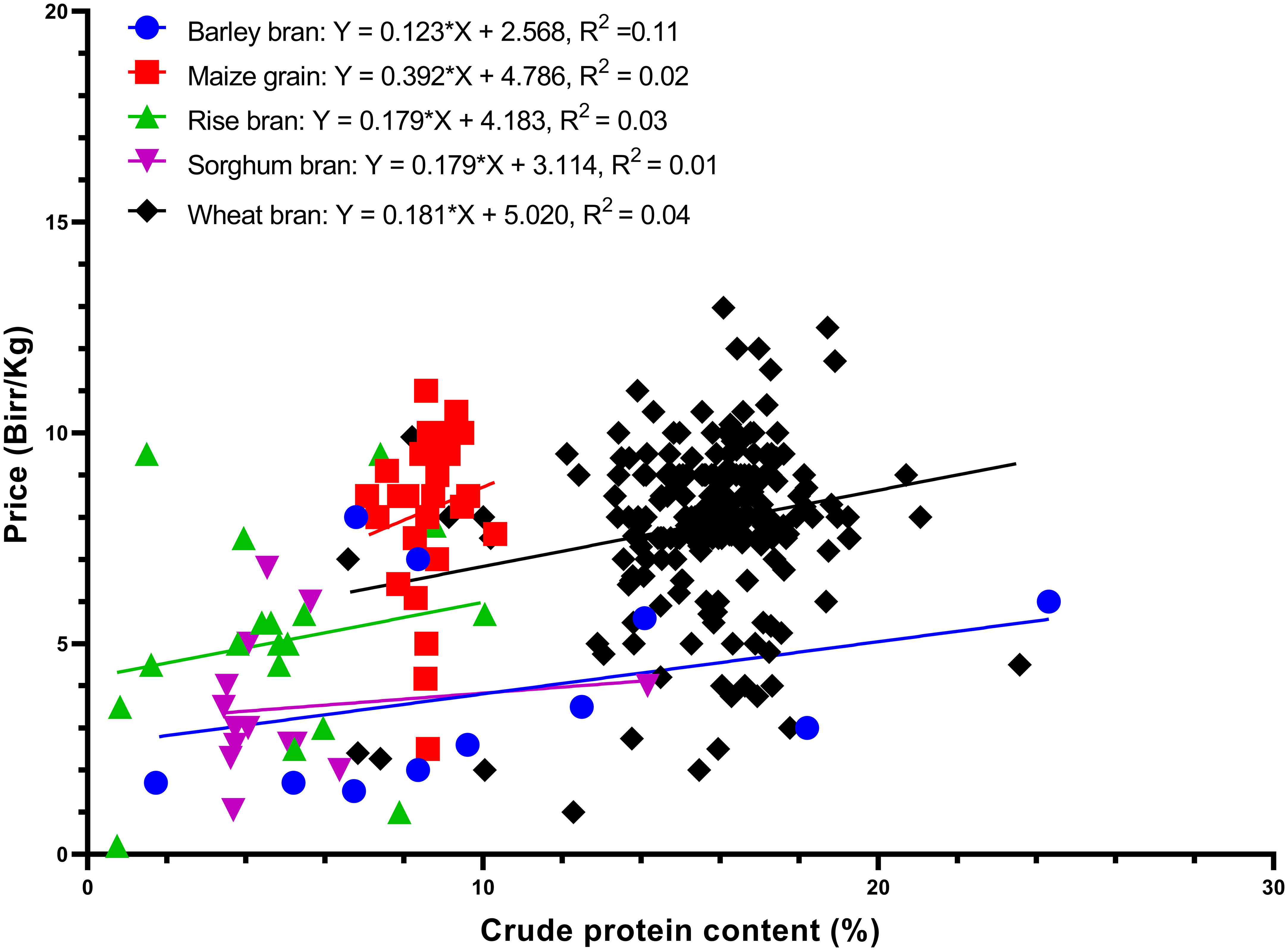
Figure 3 Relationship between price and percent crude protein content for selected cereal by- product feeds ingredients collected in selected marketplaces in Ethiopia.
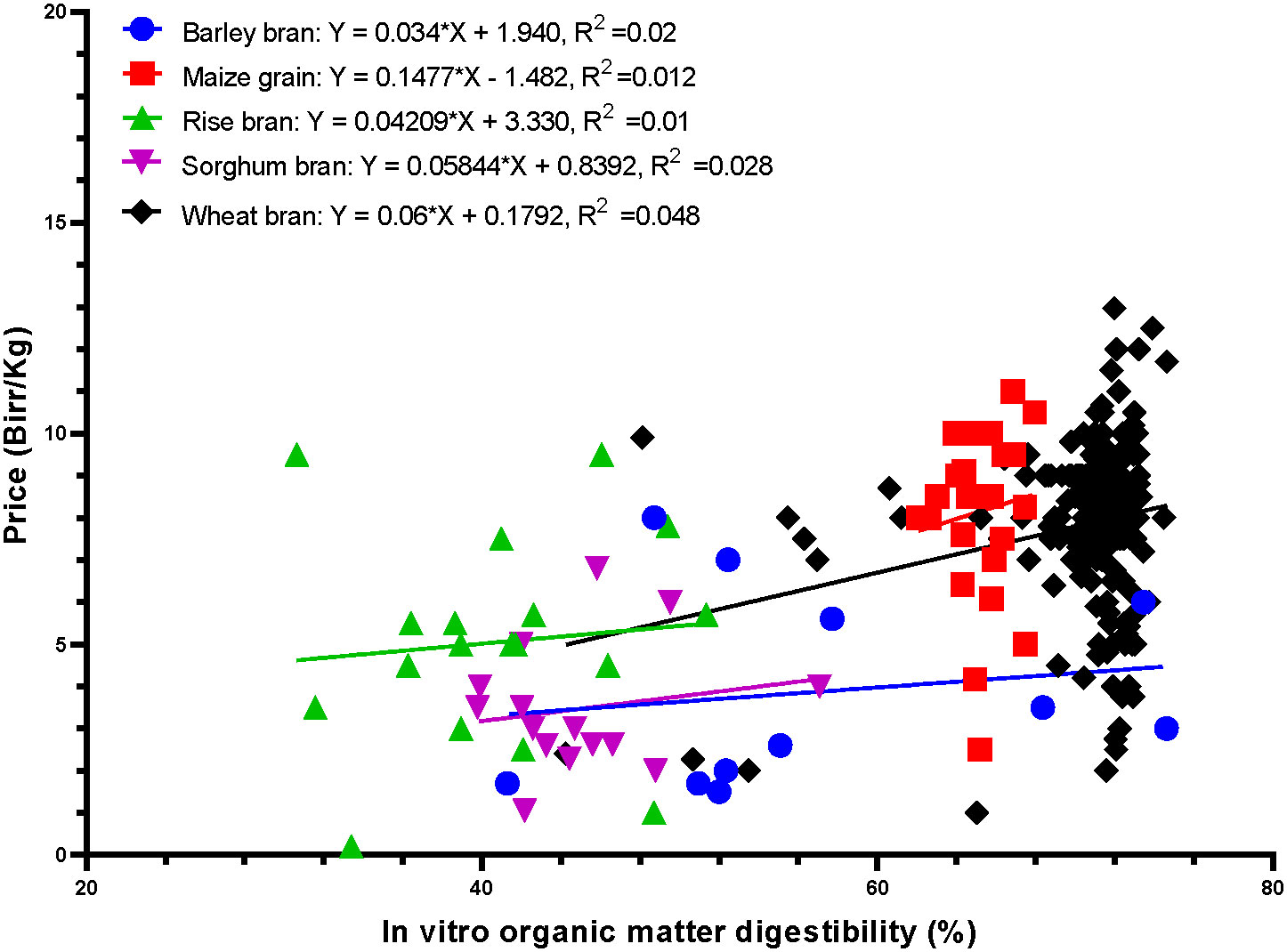
Figure 4 Relationship between price and in vitro organic matter digestibility (IVOMD) for selected cereal by-product feed collected in selected marketplaces in Ethiopia.
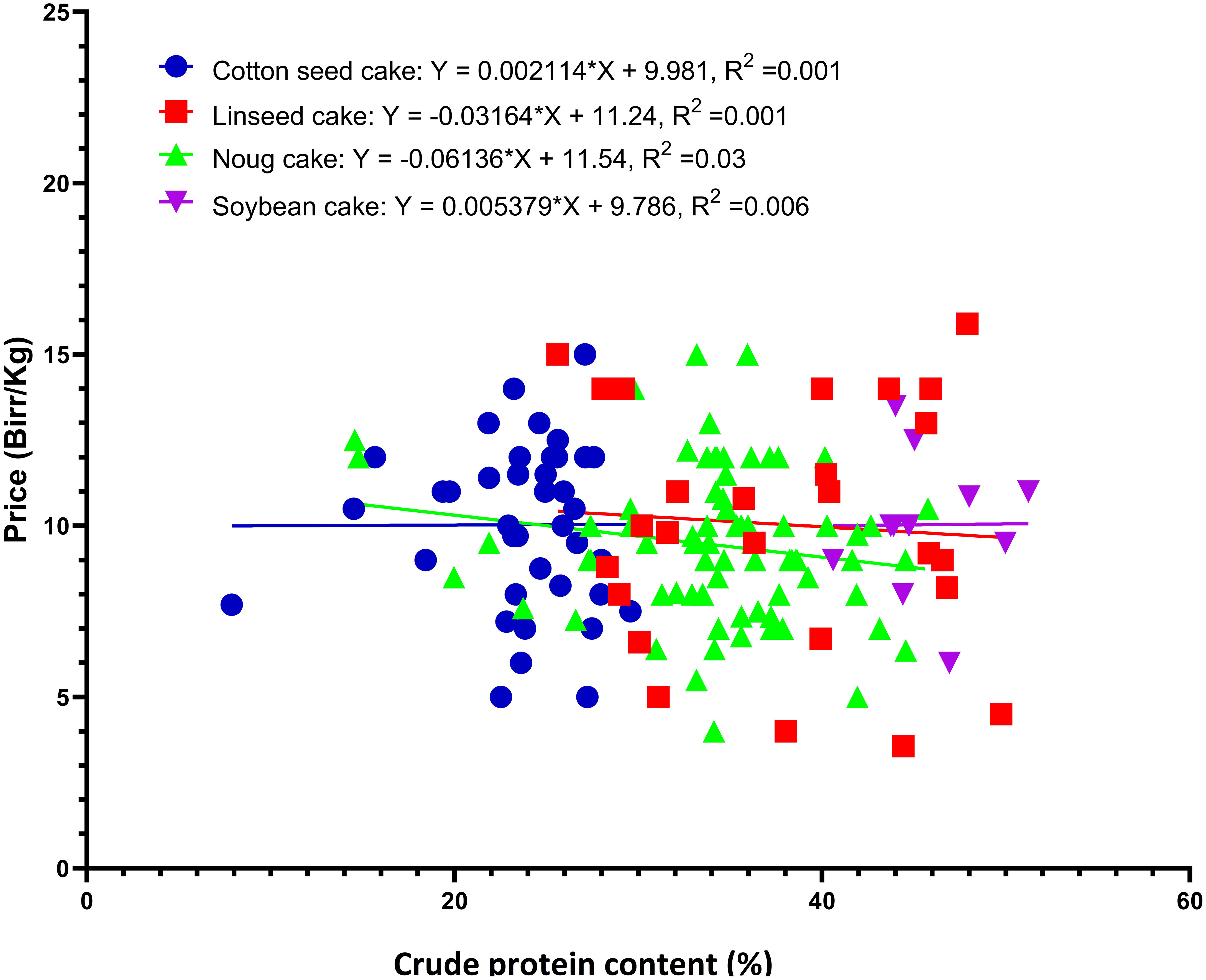
Figure 5 Relationship between price and percent crude protein content for selected oilseed cakes collected in selected marketplaces in Ethiopia.
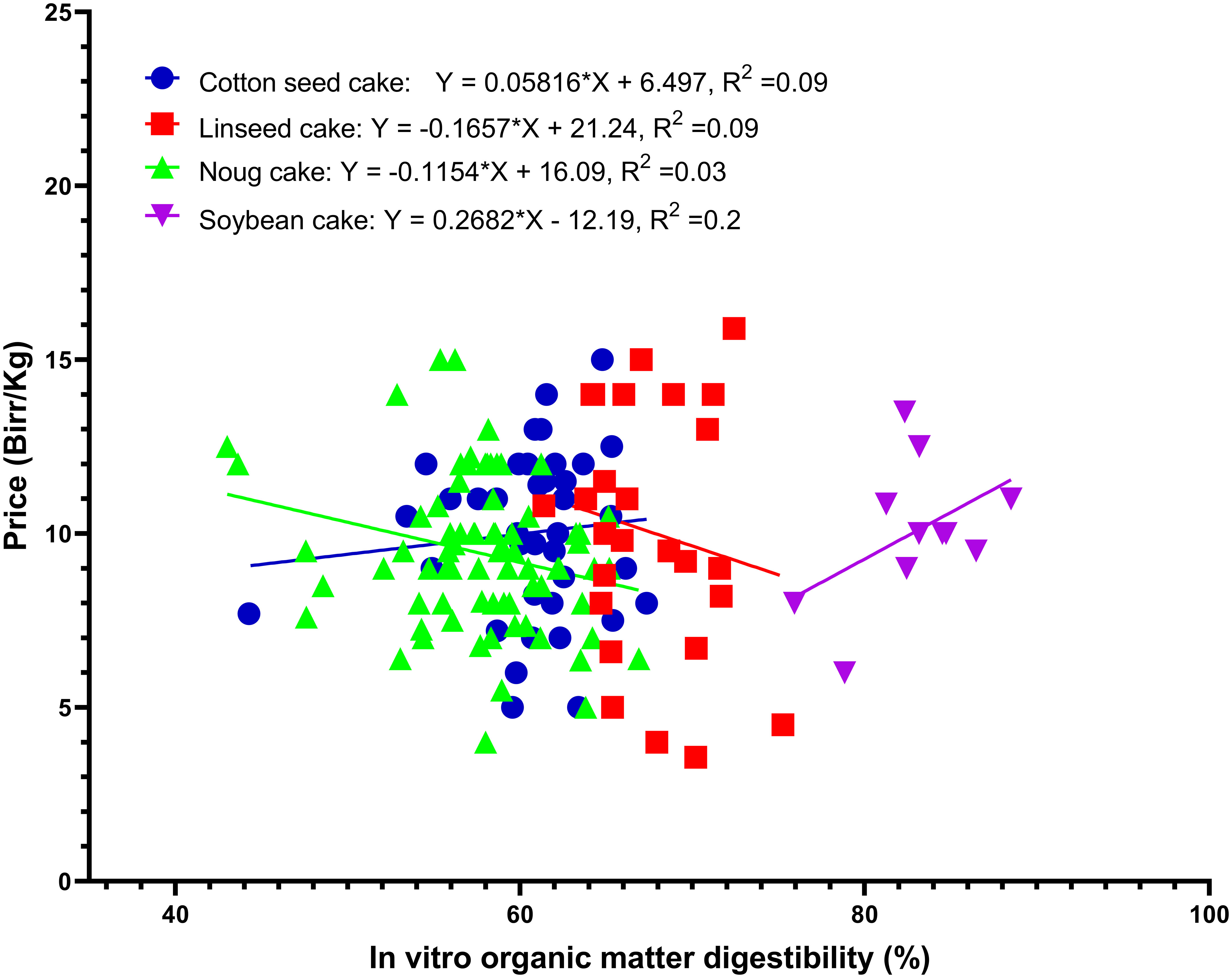
Figure 6 Relationship between price and in vitro Organic Matter Digestibility (IVOMD) for selected oilseed cakes collected in selected marketplaces in Ethiopia.
Among the roughages considered in this study, significant relationships (P<0.05) between price and quality were observed only for grass hay (Table 5; Figures 7, 8).
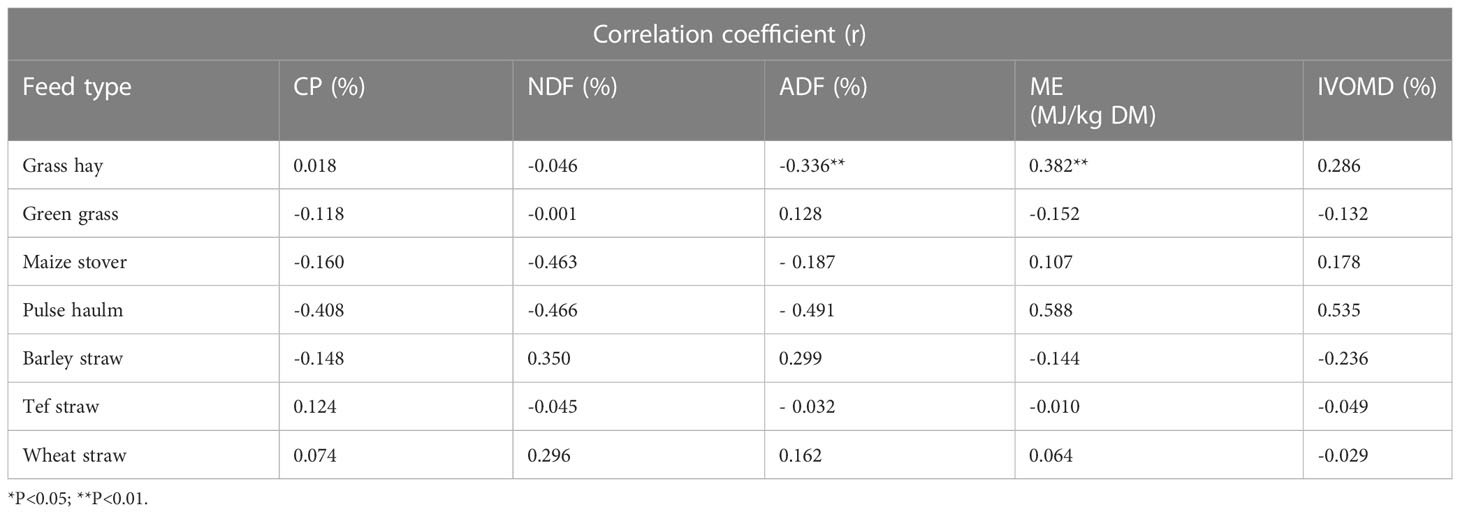
Table 5 The Pearson correlation coefficient (r) between quality and price (Birr/kg) for selected roughages collected from marketplaces.
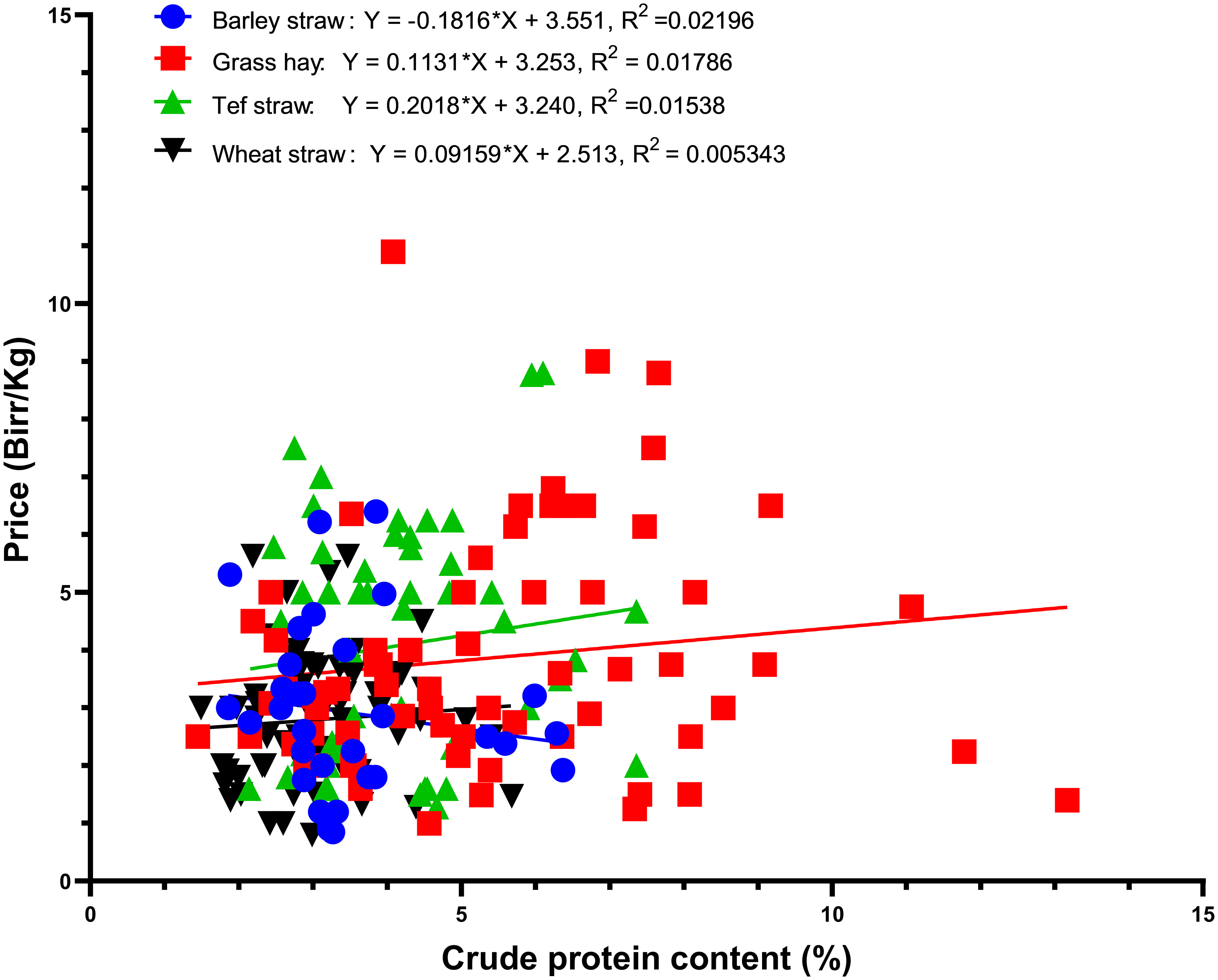
Figure 7 Relationship between price and crude protein content of selected roughages collected in selected market places in Ethiopia.
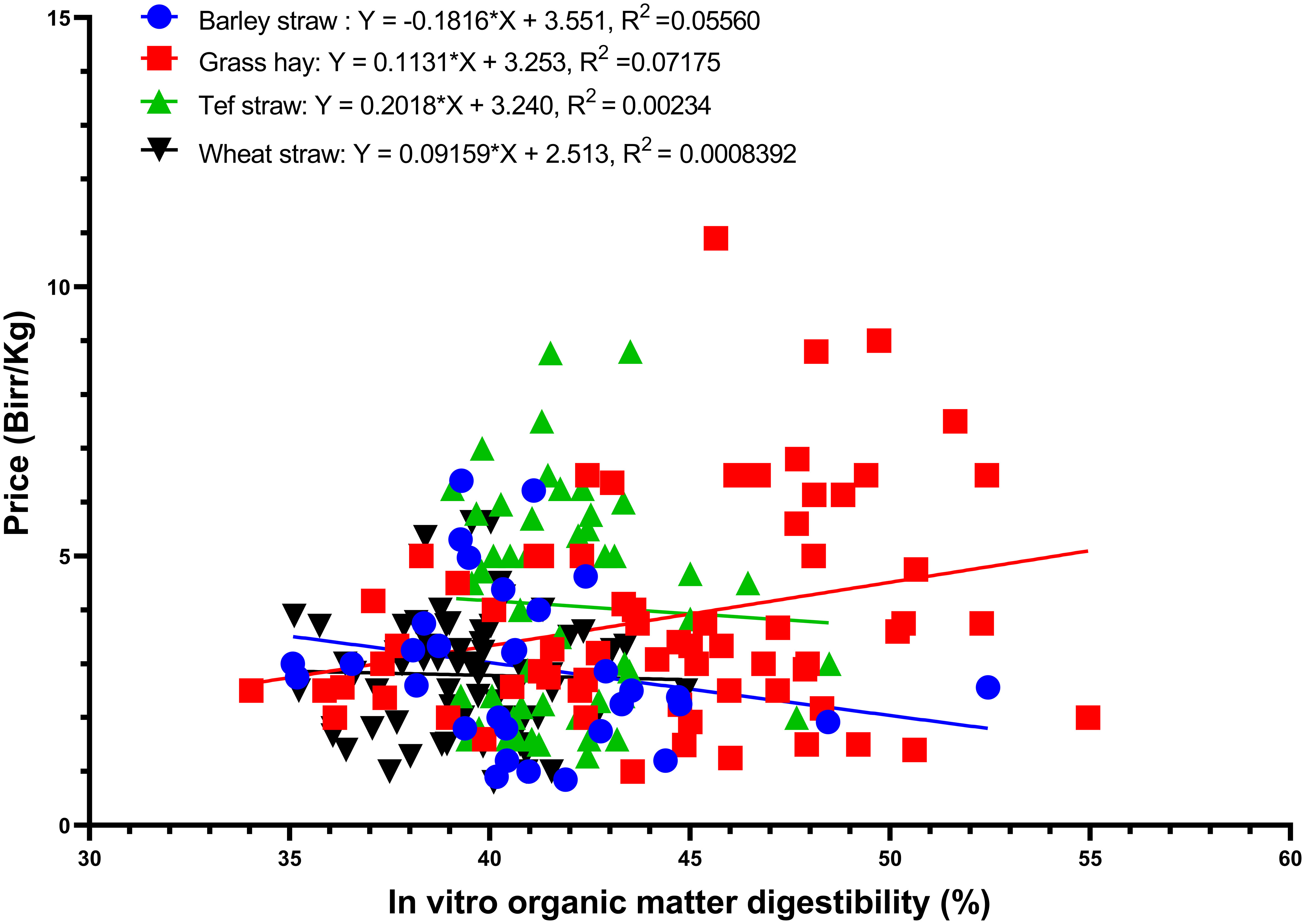
Figure 8 Relation between price and in vitro organic matter digestibility (IVOMD) for selected roughages collected in selected marketplaces in Ethiopia.
The price of compound feeds generally seems to be unrelated with quality attributes, except for the ADF content of dairy rations which was negatively related with price (P<0.05) (Table 6).

Table 6 Pearson correlation coefficient (r) between nutritive value and price (Birr/kg) for selected formulated concentrate feeds collected in selected marketplaces in Ethiopia.
Discussion
As information on Ethiopia’s feed market and its characteristics is limited (Gebremedhin et al., 2009; Bediye et al., 2018; Negash, 2022), the present study explored the feed market across the country in terms of the main feed types traded, their qualities, and price- quality relationships. Over the last few decades, the contribution of peri-urban and urban livestock production as animal source food for urban populations is increasing and this appears likely to expand in the future (FAO, 2019). Peri-urban and urban livestock keepers mainly depend on purchased feeds and the presence of a well-functioning feed market is very important for a profitable livestock enterprise. The study was conducted over a relatively short time scale of two months (April and May). Feed prices do vary seasonally as does feed quality but the collection of data over a relatively short time scale ensured a reliable snapshot of data and comparability across geographical locations.
Feed types and prices
The results of the present study indicate that the main feed types traded commercially are agro- industrial by-products, grass hay, and crop residues. This is in general agreement with previous feed market appraisals (Gebremedhin et al., 2009; Bediye et al., 2018). Agro-industrial by-products, mainly wheat bran and oilseed cakes are widely used by livestock producers as an energy and protein supplement for fattening and dairy animals (Mengistu et al., 2017). These feeds are also the main components of compound feeds formulated and marketed by feed processing companies due to their relative affordability. Efficient use of agro-industrial by-products is in fact an important feed resourcing strategy to minimize competition with cereal grains and pulses which are directly used as human food (Thieme and Makkar, 2017; (Ertl et al., 2015). Next to agro- industrial by-products, grass hay is the most common feed type traded in the central highlands owing to the presence of organized hay producing farmers with baling machine services in these areas. Availability of other roughages in the local market, especially crop residues, appears to be highly dependent on the agro-ecology of the locality, and are mostly traded loose in the informal market (Mulisa et al., 2016).
Available records show that over the last decade the prices of feeds have been increasing steadily (Bediye et al., 2018). However, the present assessment and recent reports indicate that feed prices have increased sharply over the last few years due to high inflation coupled with the widening gap between supply and demand. In several cases, the rate of increase in feed prices have been found to be higher than that of staple food crops (Ameye et al., 2021; Negash, 2022). These recent feed price surges have also been directly reflected in the price of animal source foods (Ameye et al., 2021). A typical example is the price of milk in the capital, which has increased by a factor of 2.3 in the last two years and is currently sold at 1.95 USD per litre. This highlights the necessity to establish a well-developed feed market that enables livestock producers to access affordable feed of known quality to manage production costs and improve access to and affordability of animal source foods in Low and Middle-income Countries.
Quality of feeds marketed and price-quality relationships
Several factors are known to affect the quality of feeds and the large within feed type variations in quality observed are expected (Van Soest, 1994; Capstaff and Miller, 2018), given that the sample collection covered a wide geographical spread. In the case of agro-industrial by-products, the raw material used, processing techniques and storage handling conditions could all contribute to the feed quality of the products (Bojanowska, 2017; Vidal et al., 2022). For instance, depending on the processing machine and procedures applied, wheat processing into flour could result in either wheat bran, or wheat bran and wheat middling (a finer product with higher energy concentration). However, this cereal by-product was mostly traded in the local feed market simply as wheat bran. During discussions with customers, it was noted that wheat bran was prone to adulteration, especially with sawdust. All these factors may explain the observed variation in quality of this by- product (CP: 6 – 23%; IVOMD: 44 – 75%).
Regarding oilseed cake by-products, the efficiency of the oil extraction (solvent or hydraulic methods) and presence or absence of pre-processing treatments (such as decortication or dehulling) affect the protein content of the product (Shukla et al., 1992). Solvent extraction generally provides a higher efficiency of oil extraction, resulting in high protein content in the by- product, and this technique is limited to large scale oil processing plants, while the hydraulic extraction method is applied in several small oilseed processing mills in Ethiopia. Oilseed cakes, especially those mechanically extracted, are susceptible to quality deterioration during storage and marketing unless the necessary precautions are applied. The large variations in quality of the oilseed cakes (e.g. noug seed cake, CP: 15 – 46%; IVOMD: 43 – 68%) in the present assessment appear to be due to a combination of such factors. Naturally, grass hay and other roughages are subject to high quality variations depending on the stage of harvest and drying method. Cultivar dependent variations in the fodder quality of cereal straws and pulse haulms are also well documented.
An important observation in the present study is that despite such large within-feed type differences in quality, the feed market does not offer feed products graded according to their quality. This means that regardless of quality differences, each feed type is sold under the same name. In contrast to the present results, in certain fodder markets in India, where the feed market is relatively well developed, traders segregate different residue quality classes based on sensory characteristics, with a price premium attached to the higher quality class (Duncan et al., 2020). Similarly, a series of multi-dimensional crop variety improvement programs on sorghum, pearl millet and rice in India indicated that the value of the residue from improved dual-purpose cultivars is well recognized by both traders and customers, and that premium prices are offered to the residue derived from improved dual-purpose cultivars compared to cultivars bred for seed (Blümmel et al., 2020).
Several factors may contribute to the absence of strong price quality relationships for most feed types in the Ethiopian feed market. The first appears to be a lack of commercial sophistication of livestock enterprises in the country where feeds of known quality could be purchased, and animals fed according to requirements for optimal productivity and profitability. This may be a characteristic of underdeveloped feed markets in several sub-Saharan African countries. In this regard, feed market price studies in the West African Sahel by Ayantunde et al. (2014) showed that within feed type, price quality relationships were absent and that prices were heavily influenced by availability rather than quality. The second reason may be the lack of enforced quality standards that could lead to a range of quality classes of a feed product. To operationalize such a feed market system, however, it is important to develop lab analytical capabilities to easily determine quality parameters and provide standard labels for a range of feed products. In this respect, the use of NIRS platforms to analyse feed quality parameters may be a good alternative to conventional lab analysis, which is costly for the routine analysis of large numbers of feed samples (Balehegn et al., 2022). Livestock producers in Ethiopia often do not have the access to adequate feed during seasons of scarcity. This would be the likely driver for livestock producers to focus on quantity rather than quality of feeds purchased, resulting in the lack of strong relationships between price and quality. This indicates that quality attributes have a limited role in setting market prices, and that prices are dictated by other market variables such as availability/supply and proximity to markets.
The fact that both good and poor-quality feeds are sold under the same name and market value, affects both the trader and the end user (livestock producers). Firstly, it does not encourage feed producers or formulators to strive to supply good quality feed ingredients and/or rations as there would be no price incentive for this action. Secondly, livestock producers who buy and use these feed resources could end up buying poor quality feeds with a high price that increases input costs but results in undernutrition and sub-optimal livestock production. Therefore, in the longer term it is important to build capacity in terms of creating awareness among feed market actors about existing quality variations and their implications for animal performance and profitability of livestock enterprises. Moreover, it is important to build national feed analytical capabilities, develop context specific quality standards for different feed types, and strengthen institutional market regulation mechanisms.
Conclusion
A range of feed types including agro-industrial by-products, grass hay, crop residues and compound feeds dominate the feed market in Ethiopia. The inherent feed market characteristics in the local market indicate that, despite large quality differences, most feed ingredients are not graded and priced according to their quality, and that price-quality relationships are either very weak or non-existent. This indicates that quality attributes have a limited role in setting market prices. Quality-based pricing of feed ingredients and products is imperative both for the traders and customers (buyers). Traders could ask for a premium price for a good quality product, whereas customers would save money as they would pay for a product of known quality to support improved livestock production. In conclusion, to develop a well-functioning feed market, a series of capacity building measures are needed along the feed value chain. Along with this, feed quality laboratories with rapid and affordable analytical techniques such as NIRS is essential to enable feed buyers to pay for the quality they choose.
Data availability statement
The raw data supporting the conclusions of this article will be made available by the authors, without undue reservation.
Ethics statement
Ethical review and approval was not required for the study on human participants in accordance with the local legislation and institutional requirements. Written informed consent for participation was not required for this study in accordance with the national legislation and the institutional requirements.
Author contributions
AM led the work and developed the first draft of the paper. MBez supported drafting and structuring of the paper. AA supported field activities. YA provided expertise on feed evaluation. KP oversaw NIRS analysis. RD provided statistical advice. CJ contributed to writing and conceptualization. MBlum, JH, and TA supervised the PhD project. AD contributed to writing, structure and conceptualization. All authors contributed to the article and approved the submitted version.
Funding
This work was financed by the USAID Feed the Future Innovation Laboratory for Small Scale Irrigation (ILSSI) and the CGIAR Initiative on Sustainable Animal Productivity which is supported by contributors to the CGIAR Trust Fund.; support from the Ethiopian Institute of Agricultural Research (EIAR)/Agricultural Growth Project II (AGPII) is also gratefully acknowledged. Latter stages of this work were funded by by the United States Agency for International Development (USAID) Bureau for Food Security under Agreement # AID-OAA-L-15-00003 as part of Feed the Future Innovation Lab for Livestock Systems. Funding was also provided by the Bill & Melinda Gates Foundation through the Equip - Strengthening Smallholder Livestock Systems for the Future (grant number OPP11755487) project. Any opinions, findings, conclusions, or recommendations expressed here are those of the authors alone.
Acknowledgments
The support of district bureau of agriculture livestock production experts, and researchers from EIAR and regions is highly appreciated.
Conflict of interest
The authors declare that the research was conducted in the absence of any commercial or financial relationships that could be construed as a potential conflict of interest.
Publisher’s note
All claims expressed in this article are solely those of the authors and do not necessarily represent those of their affiliated organizations, or those of the publisher, the editors and the reviewers. Any product that may be evaluated in this article, or claim that may be made by its manufacturer, is not guaranteed or endorsed by the publisher.
References
Ameye H., Bachewe F. N., Minten B. (2021). The rising price of nutritious foods: the case of Ethiopia. Global Food Secur. 31, 100582. doi: 10.1016/j.gfs.2021.100582
AOAC (1995). Official methods of analysis 16th Ed. Association of official analytical chemists. Washington DC, USA: Sci. Educ.
Asresie A. Z. L. (2015). Contribution of livestock sector in Ethiopian Economy: a review. Adv. Life Sci. Technol. 29, 79–91.
Ayantunde A. A., Blummel M., Grings E., Duncan A. J. (2014). Price and quality of livestock feeds in suburban markets of West Africa’s sahel: case study from Bamako, Mali. Rev. D’élevage. Méd. Vétérinaire. Des. Pays. Tropicaux. 67 (1), 13–21.
Balehegn M., Padmakumar V., Zampaligre N., Blummel M., Ayantunde A., Jones C., et al. (2022). Near-infrared reflectance spectroscopy for forage nutritive value analysis in sub-Saharan African countries. Agron. J. 114, 100–114. doi: 10.1002/agj2.20801
Bediye S., Nemi G., Makkar H. P. S. (2018). Ethiopian Feed industry: current status, challenges and opportunities. Broadening. Horizons. 50, 1–7.
Blümmel M., Ørskov E. R. (1993). Comparison of in vitro gas production and nylon bag degradability of roughages in predicting feed intake in cattle. Anim. Feed. Sci. Technol. 40 (2–3), 109–119. doi: 10.1016/0377-8401(93)90150-I
Blümmel M., Samireddypalle A., Zaidi P. H., Vadez V., Reddy R., Pasupuleti Janila P. (2020). Multi-dimentional crop improvement by ILRI and partners: drivers, approaches, achievements and impact in the impact of the international livestock research institute. Eds. McIntire J., Grace D. (Nairobi, Kenya: ILRI, and Wallingford, UK: CABI), 481–501.
Bojanowska M. (2017). Changes in chemical composition of rapeseed meal during storage, influencing nutritional value of its protein and lipid fractions. J. Anim. Feed. Sci. J. Anim. Feed. Sci. 26, 157–164. doi: 10.22358/jafs/74292/2017
Capstaff N. M., Miller ,. A. J. (2018). Improving the yield and nutritional quality of forage crops. Front. Plant Sci 9. doi: 10.3389/fpls.2018.00535
Central Statistical Agency (CSA) (2018). Federal democratic republic Ethiopia, central statistical agency, agricultureal sample survey 2017/2018. livestock and livestock characterstics. statistical bulletin (Addis Ababa: Federal Government of Ethiopia), 587.
Dejene M., Bediye S., Alemu D., Kitaw G., Kehaliw A., Assefa G., et al. (2014). Livestock feed marketing in Ethiopia: challenges and opportunities for livestock development. J Agric Sci Tech 4 (2A).
Duncan A. J., Bachewe F., Mekonnen K., Valbuena D., Rachier G., Lule D., et al. (2016). Crop residue allocation to livestock feed, soil improvement and other uses along a productivity gradient in Eastern Africa. Agricult. Ecosyst. Environ. 228, 101–110. doi: 10.1016/j.agee.2016.05.011
Duncan A. J., Samaddar A., Blümmel M. (2020). Rice and wheat straw fodder trading in India: possible lessons for rice and wheat improvement. Field Crops Res. 246, 107680. doi: 10.1016/j.fcr.2019.107680
Ertl P., Zebeli Q., Zollitsch W., Knaus W. (2015). Feeding of by-products completely replaced cereals and pulses in dairy cows and enhanced edible feed conversion ratio. J. Dairy. Sci. 98, 1225–1233. doi: 10.3168/jds.2014-8810
FAO (2019). The future of livestock in ethiopia. opportunities and challenges in the face of uncertainty, 48. Rom.
Gebremedhin B. A., Hirpa, Berhe K. (2009). Feed marketing in Ethiopia: results of rapid market appraisal (Addis Ababa: International Livestock Research Institute).
Jarial S., Blümmel M., Soumana I., Prasad SI, K. V. S. V., DR. (2016). Price quality relationships in fodder trading in Niger with special regards to comparison of cowpea and groundnut haulms with concentrates, collected shrubs and grasses. In: Pan African Grain Legume and World Cowpea Conference, 27 Feb - 4 Mar 2016.
Mayberry D., Ash A., Prestwidge D., Godde C. M., Henderson B., Duncan A., et al. (2017). Yield gap analyses to estimate attainable bovine milk yields and evaluate options to increase production in Ethiopia and India. Agric. Syst. 155, 43–51. doi: 10.1016/j.agsy.2017.04.007
Menale, Melaku (2019). Urban and peri-urban dairy cattle production in Ethiopia: a review. Online J. Anim. Feed. Res. 9, 173–177.
Mengistu A., Kebede G., Feyissa F., Assefa G. (2017). Review on major feed resources in Ethiopia: conditions, challenges and opportunities. Acad. Res. J. Agric. Sci. Res. 5, 176–185.
Mengistu S., Nurfeta A., Tolera A., Bezabih M., Adie A., Wolde-meskel E., et al. (2021). Livestock production challenges and improved forage production efforts in the Damot Gale District of Wolaita Zone, Ethiopia. Advances in Agriculture 2021, 1–10.
Menke K. H., Steingass H. (1988). Estimation of the energetic feed value obtained from chemical analysis and in vitro gas production using rumen fluid. Anim. Res. Dev. 28, 7–55.
Negash D. (2022). Study on compound animal feed demand and animal products, supply, price and marketing in Ethiopia. BioMed. J. Sci. Tech. Res. 41 (3), 32808–32817. doi: 10.26717/BJSTR.2022.41.006619
Shapiro B. I., Gebru G., Desta S., Negassa A., Nigussie K., Aboset G., et al. (2017). Ethiopia Livestock sector analysis: a 15 year livestock sector strategy. ILRI. Project. Rep., 1–103.
Shukla B. D., Srivastava P. K., Gupta R. K.. (1992). Oilseeds processing technology. Bhopal, India: Central Institute of Agricultural Engineering.
Thieme O., Makkar H. P. S. (2017). Utilisation of loss and waste during the food-production cycle as livestock feed. Animal Production Science 57 (4), 601–607.
Van Soest P. J., Robertson J. B. (1985). Analysis of forages and fibrous foods. a laboratory manual for animal science 613 (Ithaca, New York, USA: Cornell University).
Vidal N. P., Roman L., Swaraj V. J. S., Ragavan K. V., Simsek S., Rahimi J., et al. (2022). Enhancing the nutritional value of cold-pressed oilseed cakes through extrusion cooking. Innovative. Food Sci. Emerging. Technol. 77, 102956. doi: 10.1016/j.ifset.2022.102956
Yami M., Meyer F., Hassan R. (2020). The impact of production shocks on maize markets in Ethiopia: implications for regional trade and food security. Agric. Food Economics. 8, 8. doi: 10.1186/s40100-020-0153-5
Keywords: specialty section: animal nutrition Ethiopia, livestock, feed, nutritive analysis, price left
Citation: Melesse A, Bezabih M, Adie A, Asmare Y, Prasad KVSV, Devulapalli R, Jones CS, Blummel M, Hanson J, Alemu T and Duncan AJ (2023) Price-quality relationships for the main livestock feed types in the Ethiopian feed market. Front. Anim. Sci. 4:1194974. doi: 10.3389/fanim.2023.1194974
Received: 27 March 2023; Accepted: 14 June 2023;
Published: 19 July 2023.
Edited by:
Elaine Grings, Retired, Prescott Valley, AZ, United StatesReviewed by:
Halima Sultana, University of Florida, United StatesDustin L Pendell, Kansas State University, United States
Copyright © 2023 Melesse, Bezabih, Adie, Asmare, Prasad, Devulapalli, Jones, Blummel, Hanson, Alemu and Duncan. This is an open-access article distributed under the terms of the Creative Commons Attribution License (CC BY). The use, distribution or reproduction in other forums is permitted, provided the original author(s) and the copyright owner(s) are credited and that the original publication in this journal is cited, in accordance with accepted academic practice. No use, distribution or reproduction is permitted which does not comply with these terms.
*Correspondence: Alan J. Duncan, a.duncan@cgiar.org
 Adey Melesse
Adey Melesse Melkamu Bezabih
Melkamu Bezabih Aberra Adie3
Aberra Adie3  Yonas Asmare
Yonas Asmare Kodukula V. S. V. Prasad
Kodukula V. S. V. Prasad Ravi Devulapalli
Ravi Devulapalli Chris S. Jones
Chris S. Jones Tesfaye Alemu
Tesfaye Alemu Alan J. Duncan
Alan J. Duncan